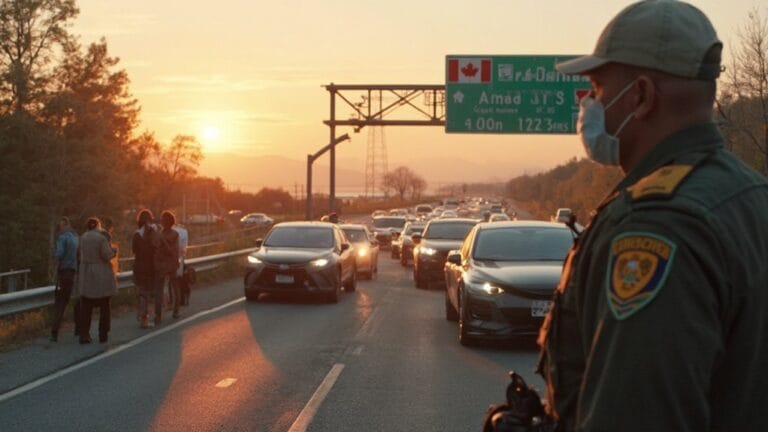Maneuvering borders as a temporary visa holder can feel like a circus act, but with a few tricks up your sleeve, you’ll ace it! First, keep your documents—passports, visas, and bank statements—organized and ready. Know your visa requirements inside and out, because the last thing you want is a surprise at the border. Be calm and courteous during inspections; confidence goes a long way! Also, consider Trusted Traveler Programs to speed things up. And don’t forget to pack a basic itinerary and hotel bookings! Stick around—there’s much more to discover about making your border experience smooth and easy!
Key Takeaways
- Organize and keep all essential travel documents, including visas and passports, easily accessible to streamline the border crossing process.
- Prepare for primary inspection by having documents in order and being ready for digital fingerprinting to avoid delays.
- Maintain a calm and respectful demeanor during border interactions to enhance communication with officials and facilitate a smoother experience.
- Familiarize yourself with specific visa requirements and ensure all documentation is complete to avoid complications during your entry.
- Utilize Trusted Traveler Programs like Global Entry or NEXUS to expedite your crossing and reduce waiting times at the border.
Valid Document Checklist
When preparing for your temporary visa application, what documents do you really need? You’ll want to kick things off with some solid document organization. Think of it like packing for a trip; you don’t want to forget your toothbrush! First, grab your valid passport, the Temporary Resident Visa Application Form (IMM 5257), and the Family Information Form (IMM 5707). And don’t forget those two passport-sized photos—trust me, they’ll come in handy!
Next up, you’ll need proof of identity and financial support. A photocopy of your passport’s info page, along with a letter from your employer and recent bank statements, will show you’re set to support yourself during your stay. It’s also crucial to be aware that a Canadian Visitor Visa is necessary for entry into Canada.
For the purpose of your travel, draft a letter explaining why you’re visiting, plus a basic itinerary and any hotel bookings or flight reservations you have.
Lastly, if you’ve got kids, you might need custody documents or a letter from their other parent. Using a checklist can enhance your checklist efficiency—crossing off items feels great! So, stay organized, and you’ll breeze through this visa prep like a pro!
Understand Your Visa Requirements
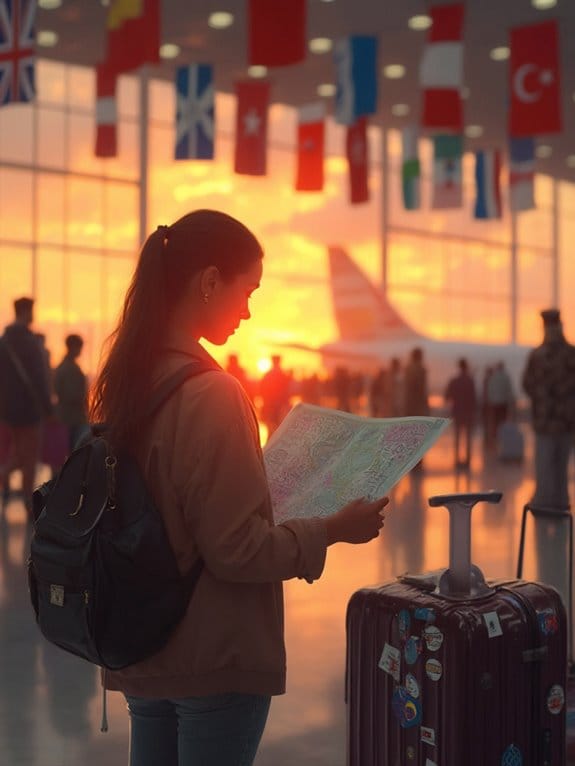
After gathering your documents, it’s time to understand your visa requirements. You might think it’s a hassle, but getting familiar with your visa categories can save you a lot of headaches down the road. Temporary visas are often for non-immigrant purposes like tourism, work, or studying. Depending on your situation, you could fall under various types, like the H-2B for seasonal work or the P-3 for artists. Additionally, seeking professional assistance can greatly simplify your visa application process.
Now, let’s talk about the application process. Most temporary worker visas need an approved petition from USCIS, so don’t skip that step! You’ll also have to book an interview at a U.S. embassy or consulate, and trust me, they’ll want specific documents, like a passport that’s valid for at least six months beyond your stay.
Prepare Financial Proof
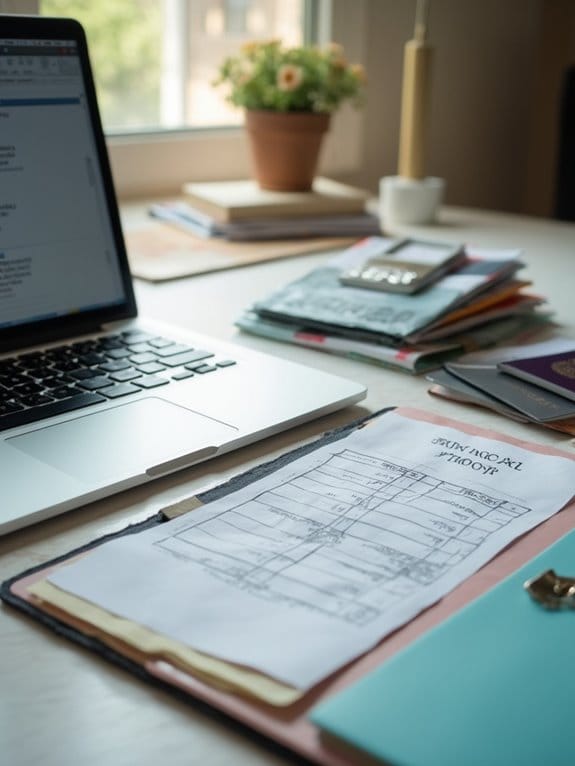
Gathering financial proof is a crucial step in your visa application process, so don’t overlook it. You’ll want to show you can support yourself while traveling, and financial sponsorship from a host can really help. Start by collecting bank statements or deposit books that show your savings. If you’re lucky enough to have a job, grab those letters of employment detailing your position, start date, and annual earnings.
If your host is footing the bill, they should provide evidence of their income, like a Revenue Canada Notice of Assessment. You might even need to clarify family size to show they can handle extra visitors. Don’t forget alternative forms of proof! Verbal or written statements from friends or family can work wonders, as can cash, certified checks, or money orders. It’s important to remember that financial stability is demonstrated through consistent employment or savings, which can positively influence the assessment process.
Clarity is key here—make sure your documentation is easy to read and understand. And if you have scholarships or family backing, mention them too. With clear evidence, you’re setting yourself up for a smoother journey, turning the challenging process of applying for a visa into something a little more manageable. So, get organized and show ’em what you’ve got!
Confirm Travel Arrangements
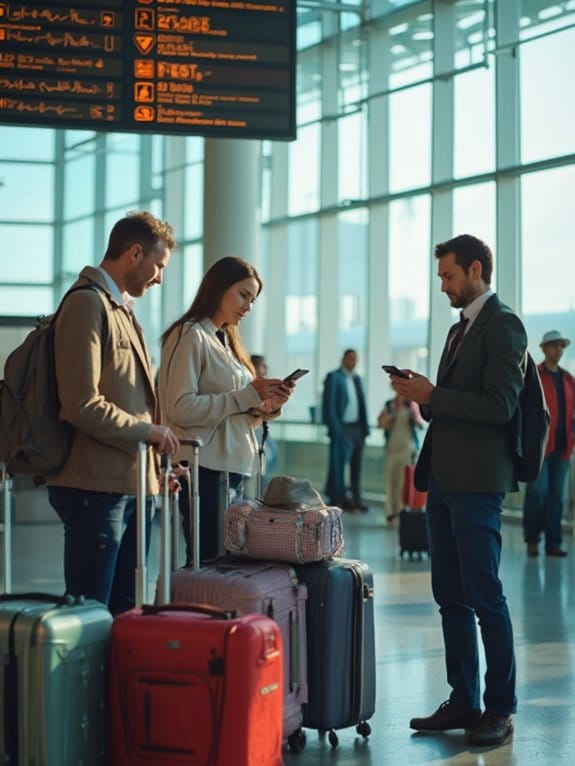
Confirming your travel arrangements is essential to guarantee a smooth journey, as it not only helps you avoid last-minute surprises but also supports your visa application. First off, make sure all your travel documentation is in order—think visas, passports, and any permits you might need. Nothing ruins a trip faster than a forgotten document!
Next, have proof of your flight and accommodation handy. It’s super helpful to have hotel reservations or letters from hosts at your fingertips. And don’t forget your itinerary! Write down all your planned destinations and dates; this can make border crossings a breeze. Be aware that return wait times can exceed two hours, especially on Sundays, which could impact your journey.
When it comes to travel safety, doing your homework on border crossing specifics—like fees or tolls—is key. For example, if you’re crossing the Eagle Pass International Bridge, be ready for those tolls!
Lastly, emergencies happen, so keep a list of emergency contacts close. Know how to get expedited travel documents if you need them. By confirming these arrangements, you’re not just planning a trip; you’re ensuring a fantastic experience!
Navigate Primary Inspection
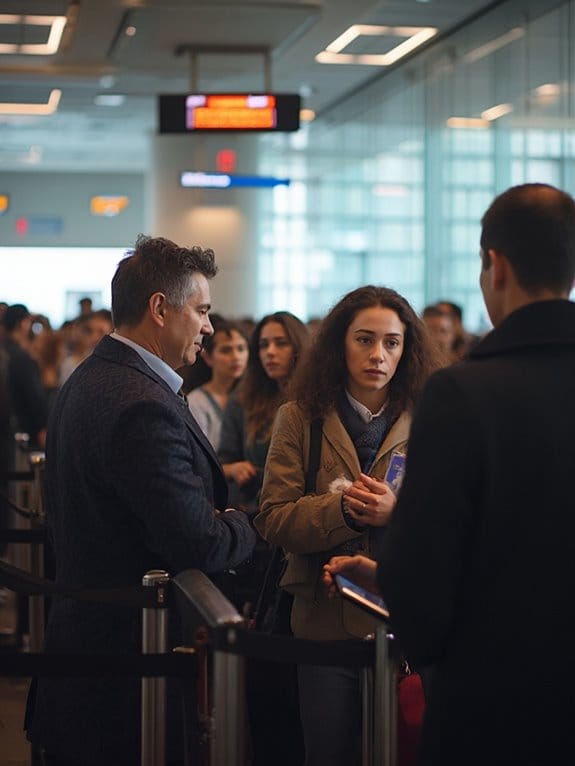
Maneuvering primary inspection can feel intimidating, but being well-prepared makes all the difference. Imagine this: you’re standing in line, heart racing, wondering what’s next. First off, remember the primary inspection tips! When you get to the officer, they’ll take your digital fingerprints, so just relax—it’s quick and painless, unless you’re a toddler or certain visa holders, who might be exempt.
As the officer verifies your identity, they’re checking your name against databases, so accuracy is key. That means having your documents in order! Confidence is essential, too—avoid any suspicious behavior. You don’t want them thinking you’re hiding something. A little etiquette goes a long way; remove your hat and sunglasses, roll down your window, and turn off the radio. It shows respect and openness. Additionally, be prepared for the possibility of needing to present a sealed envelope with immigration file if required.
Oh, and brace yourself for the possibility of long lines—especially during peak hours. Trust me, it can feel like waiting for your favorite concert to start! So, stay calm, keep your documentation handy, and remember, this is just a small step in your journey. You’ve got this!
Anticipate Common Questions
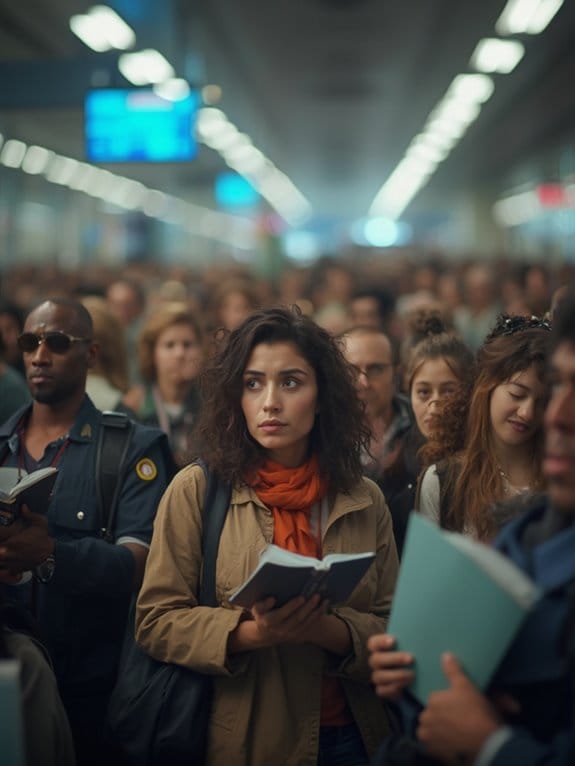
When you approach the border, expect a few common questions that can catch you off guard if you’re unprepared. One of the first things they might ask is for purpose clarification. So, be ready to explain why you’re visiting. Whether it’s for tourism, business, or to see family, having a clear and concise reason helps.
Next, they’ll likely inquire about your accommodation details. It’s crucial to show where you’ll be staying, whether it’s a hotel reservation or a friend’s place. If you can present evidence, like a printout of your booking, you’ll look more prepared and serious about your stay.
Don’t forget about your travel history, too! If you’re a first-timer, think of some extra details to share about your home ties, like family or a job that’ll bring you back. Additionally, make sure you have all travel documents organized and accessible, as this can help streamline your entry process.
And remember, staying calm and polite during this process goes a long way. If you can answer these questions confidently, you’ll not only ease your own nerves but also make a good impression. So, go on, prepare yourself—your adventure awaits!
Consider Trusted Traveler Programs
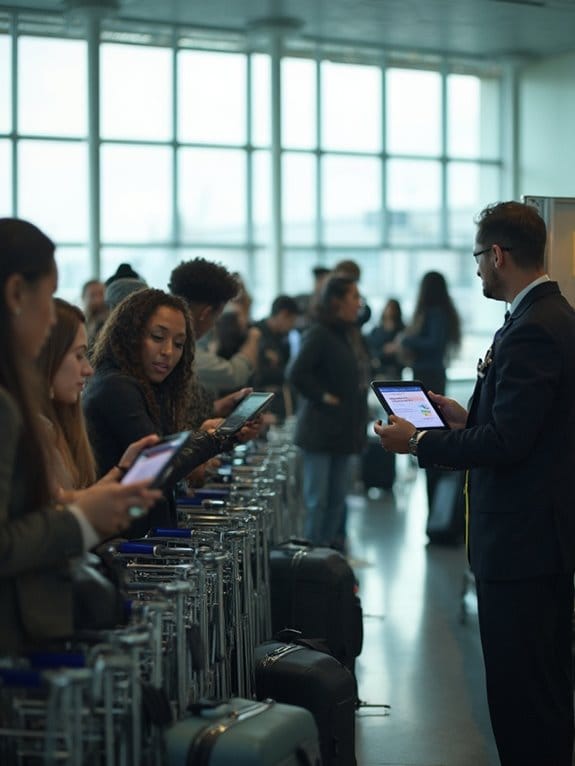
If you’re a temporary visa holder looking to streamline your travel experience, considering Trusted Traveler Programs (TTP) can be a smart move. These programs are designed to make your life easier by speeding up the screening process at airports and borders. Imagine breezing through customs while others stand in long lines—yeah, it’s that good!
Now, let’s talk about program eligibility. Depending on where you’re from, you might qualify for programs like Global Entry or NEXUS, which are all about getting you through faster. However, the application process involves filling out an online form, paying a non-refundable fee, and having an in-person interview. It sounds a bit intimidating, right? But trust me, it’s worth it. Expedited processing through these programs significantly reduces wait times at security checkpoints.
Once you’re in, you can use expedited lanes, which means less waiting and more time enjoying your travel adventures. And if you ever face a hiccup—like being denied membership—don’t worry! There’s a reconsideration process to help you out. So, if you want to save time and reduce travel stress, plunge into the world of Trusted Traveler Programs. You won’t regret it!
Special Health and Security Considerations

Maneuvering the health and security landscape as a temporary visa holder is essential for a smooth travel experience. First off, don’t forget that many countries, like Australia and New Zealand, require health examinations before you can get that coveted visa. In Australia, for example, you’ll need a medical exam and possibly a chest x-ray, depending on your situation. If you’ve had health examinations in the past year, you might be in luck and get an exemption! Additionally, effective November 1, 2023, health examination exemptions for temporary visa applicants have ceased, making it crucial to stay updated on these new requirements.
Now, let’s not skip the security protocols. Staying informed is key. Check out official government websites for updates on safety conditions and visa requirements at your destination. Programs like the Smart Traveler Enrollment Program (STEP) are lifesavers, keeping you in the loop about health and safety alerts while providing emergency contacts if you need them.
Maintain Clear Communication
Maintaining clear communication is essential for temporary visa holders maneuvering the complexities of immigration and travel. Imagine you’re at the airport, your heart racing as you approach the border control. You need to guarantee your visa status verification is spot on. Always check the I-94 website for the most up-to-date info on your visa—trust me, it can save you from unexpected surprises!
Keep an eye on those electronic notifications from CBP, too. They might send you reminders about your stay, which can prevent potential overstay violations. It’s like having a friendly nudge from a buddy, reminding you to keep things in check.
When it comes to pre-boarding, you don’t want to be caught off guard. Airlines can deny boarding if there’s a whiff of a visa issue, particularly due to previous violations of visa terms. So, stay informed about immigration updates and know your legal obligations.
Lastly, always carry your immigration documents—passport, U.S. visa, and I-94—when traveling within the U.S. You never know when you might need to whip them out! Solid communication and preparation go a long way, helping you navigate border checkpoints with confidence.
Stay Calm and Respectful
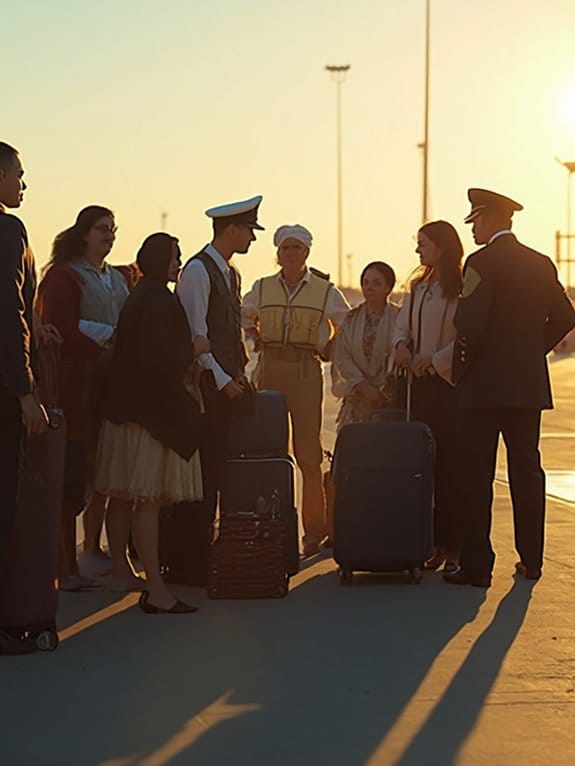
When approaching the border, staying calm and respectful can make all the difference. Imagine you’re in line, and the tension is palpable. You can feel your heart racing, but here’s the secret: keep your cool. Losing your temper only invites extra scrutiny. Remember, border etiquette is all about emotional intelligence—your demeanor can set the tone for the whole interaction.
Make sure to turn off any loud music or distractions, allowing for clear communication. If you’re driving, take the lead as the calm spokesperson. Passengers, stay quiet and only answer questions when asked, keeping it brief.
Preparation is key. Have your documents ready and easily accessible. If you’ve got kids, prep them for basic questions—they’ll appreciate it when the time comes! Additionally, it’s important to have necessary visas and permits in hand to ensure a smooth process. If you can, choose a less busy port of entry to dodge the madness.
Ultimately, being organized helps maintain that calm and respectful vibe. Honesty is essential too; straightforward answers go a long way. So, take a deep breath, stay respectful, and you’ll sail through the border with ease. You got this!
Frequently Asked Questions
Can I Travel With a Temporary Visa to Multiple Countries?
Yes, you can travel with a temporary visa to multiple countries, but you’ll need to guarantee your visa’s validity aligns with travel restrictions. Always check specific entry requirements for each country you plan to visit.
What Should I Do if My Documents Are Lost or Stolen?
If your documents are lost or stolen, follow lost document procedures. File a police report, gather essential documentation, report to embassies, and apply for replacement documents. Don’t forget to seek stolen passport advice for guidance.
How Can I Update My Accommodation Plans After Arrival?
Updating your accommodation plans is like steering a winding river; it requires careful attention. You’ll need to assess your accommodation options, document your relocation process, and guarantee you’re compliant with local regulations to avoid complications.
Are There Any Customs Restrictions on Personal Items?
Yes, there are customs restrictions on personal items. You’ll need to complete customs declarations detailing your items. Be mindful of prohibited goods and guarantee everything’s for personal use, not for sale or business.
What Happens if I Overstay My Temporary Visa?
If you overstay your temporary visa, you’ll face serious visa consequences, including potential bans and deportation. It’s essential to explore legal options early, like applying for extensions or seeking advice to manage your situation properly.





